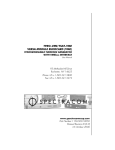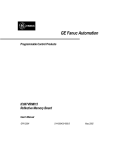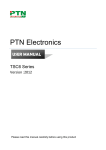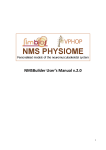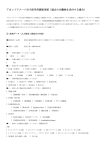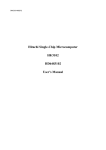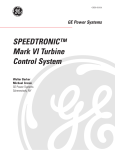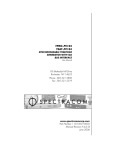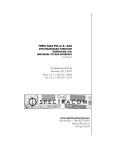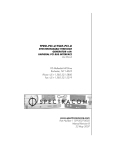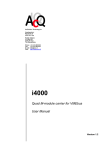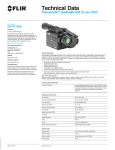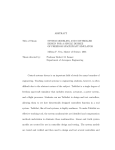Download User Manual
Transcript
User Manual Models TPRO-VME and TSAT-VME Synchronizable Timecode Generator with VMEbus Interface and GPS-based Synchronizable Timecode Generator with VMEbus Interface Edition 1.4 ________________________________________________________________________ ?Technical Support Our engineering team is available to answer your questions from 8:30 a.m. to 5:00 p.m. Monday through Friday, U.S. Eastern Time. Should you need technical assistance, the back cover of this manual gives full information on how to contact us. ________________________________________________________________________ MODEL TPRO-VME and TSAT-VME USER MANUAL Edition 1.4—September 2004 A Publication of KSI, Inc.® © MMIV Printed in the United States of America. All rights reserved. Contents of this publication may not be reproduced, stored in or transmitted by a retrieval system, or transmitted in any form or by any means, electronic or mechanical, including photocopying or recording, without the written permission of DSPCon, Inc. DSPCon has worked to verify the accuracy of the information contained in this document as of its publication date; however, such information is subject to change without notice and DSPCon is not responsible for any errors that may occur in this document. Receipt or possession of this document does not convey any rights to manufacture or reverse-engineer anything it may describe or imply, in whole or in part. ® “KSI” and the KSI logo are registered trademarks of DSPCon, Incorporated. Trademarks are acknowledged and are the property of their owners. D OCUMENT R EVISION H ISTORY Revision Date Revision No. Revised Section(s) Comments/Notes September 2004 1.4 All Completely reformatted to reflect new design. New contact information added. Language errors corrected; no substantive content modified. October 2003 1.3 NA Contact information updated. April 2002 1.2 Chapter 9 May 2001 1.1 All March 2001 —— —— Added this chapter. Completely reformatted to reflect new design. Initial Revision To download the latest version of this document, visit the KSI website @ www.ksi-corporation.com KSI User Manual Page i Contents CHAPTER ONE—OVERVIEW ................................................................................................................................. 2 Product Description....................................................................................................................................................2 General Information about GPS ...............................................................................................................................6 Inspection.....................................................................................................................................................................7 Unpacking the Unit ..............................................................................................................................................7 CHAPTER TWO—SPECIFICATIONS .................................................................................................................... 10 Board Specifications .................................................................................................................................................10 Table 2.1—Dimensions, Power, Fabrication & Temperature ....................................................................10 VMEbus Interface................................................................................................................................................10 Data Type .......................................................................................................................................................10 Addressing Type ...........................................................................................................................................10 Inputs....................................................................................................................................................................11 Table2.2—Inputs........................................................................................................................................11 Outputs.................................................................................................................................................................11 Table 2.3—Outputs....................................................................................................................................11 LED Indicators.....................................................................................................................................................11 Timing ..................................................................................................................................................................12 Table 2.4—Timing .....................................................................................................................................12 Front Panel.................................................................................................................................................................12 J6 Timecode Input ...............................................................................................................................................12 J1 20-pin Ribbon Cable Connector....................................................................................................................13 Table 2.5—Pin-out of Front Panel J1 Connector for TPRO-VME............................................................13 Rear Panel ..................................................................................................................................................................14 P1 and P2 VMEbus Interface and User-Defined Signals ...............................................................................14 Table 2.6—Direct Time (“Zero Latency”) Outputs on P2 ........................................................................14 GPS Receiver/Antenna............................................................................................................................................15 Table 2.7—GPS Receiver/Antenna Specifications (TSAT–PMC Only) ...................................................15 Optional Cable.....................................................................................................................................................15 Table 2.8—Optional Extension Cable for (TRIM-CAB-PMC-100) ..........................................................15 CHAPTER THREE—CONFIGURATION ............................................................................................................... 18 General .......................................................................................................................................................................18 VME Base Address ...................................................................................................................................................18 Case 1....................................................................................................................................................................19 Case 2....................................................................................................................................................................19 Case 3 (default)....................................................................................................................................................19 Case 4....................................................................................................................................................................19 Table 3.1—P16 Jumper Set ........................................................................................................................20 Table 3.2—Address Line and P4 Pin .........................................................................................................21 Table 3.3—Address Line and P6 Pin .........................................................................................................22 Models TPRO-VME and TSAT-VME Q Synchronizable Timecode Generators Edition 1.4 KSI User Manual Page ii Table 3.4—Address Line and P7 Pin .........................................................................................................23 VMEbus Interrupt Level ..........................................................................................................................................25 Table 3.5—P5 Jumper Set ..........................................................................................................................25 Rate Outputs Configuration....................................................................................................................................26 Table 3.6—Rate Pin Connectors ................................................................................................................27 VMEbus P2 Configuration ......................................................................................................................................28 Table 3.7—P2 Configuration .....................................................................................................................29 Time Tag Enable/Disable........................................................................................................................................30 FIFO Buffer Clear Configuration............................................................................................................................32 Table 3.8—Clear FIFO Settings.................................................................................................................33 VMEbus Address Configuration ............................................................................................................................34 A16 Base Address Configuration......................................................................................................................34 Table 3.9—A16 Short Address Configuration...........................................................................................34 Table 3.10— A16 Base Address Configuration Example...........................................................................35 A24 Base Address Configuration......................................................................................................................35 Table 3.11—A24 Standard Address Configuration ...................................................................................35 Table 3.12— Sample A24 Base Address Configuration.............................................................................35 A32 Base Address Configuration......................................................................................................................36 Table 3.13—A32 Extended Address Configuration...................................................................................36 Table 3.14— Sample A32 Base Address Configuration.............................................................................36 Interrupt Request Level Configuration .................................................................................................................37 Table 3.15—Interrupt Priority Configuration...........................................................................................37 VMEbus P2 I/O Configuration...............................................................................................................................37 Table 3.16—Terminal Strip P11 Pin Assignments ...................................................................................38 Table 3.17—Terminal Strip P12 Pin Assignments ...................................................................................38 Table 3.18—VME P2 Connector Configuration Example.........................................................................38 Rate Output Configuration .....................................................................................................................................39 Table 3.19—Terminal Strip P13 Pin Assignments ...................................................................................39 Table 3.20—Rate Configuration Example .................................................................................................39 External/Internal Event Configuration .................................................................................................................40 FIFO Buffer Clear Configuration............................................................................................................................40 EEPROM Enable .......................................................................................................................................................40 CHAPTER FOUR—PIN ASSIGNMENTS .............................................................................................................. 42 Test Points..................................................................................................................................................................42 Table 4.1—Test Point Assignments...........................................................................................................42 Table 4.2—Test Point Assignments...........................................................................................................42 Input/Output Pin Assignments .............................................................................................................................43 Table 4.3—J1 (20 pin) I/O .........................................................................................................................43 Table 4.4—J3 (SMB) IRIG-B Output J5 (BNC)........................................................................................43 Table 4.5—P8 GP STAR I/O.....................................................................................................................44 Table 4.6—P2 Parallel Outputs.................................................................................................................45 CHAPTER FIVE—INSTALLATION........................................................................................................................ 48 General .......................................................................................................................................................................48 External GPS Receiver/Antenna Installation .......................................................................................................49 Routine Maintenance..........................................................................................................................................50 Propagation Delay Adjustment ..............................................................................................................................51 Models TPRO-VME and TSAT-VME Q Synchronizable Timecode Generators Edition 1.4 KSI User Manual Page iii CHAPTER SIX—PROGRAMMING ........................................................................................................................ 54 Introduction...............................................................................................................................................................54 Register Map .............................................................................................................................................................54 Table 6.1—Addressing Base: A6 to A31 Configurable by Wire Wrap ......................................................54 Determining Address Space....................................................................................................................................55 Reading Time ............................................................................................................................................................55 Table 6.2—Low Order D32 Register (Base+18) ........................................................................................56 Table 6.3—High Order D32 Register (Base+14).......................................................................................56 Reading Latitude, Longitude, and Elevation........................................................................................................56 Table 6.4—Extra TPRO-VME Commands for Position Reports ..............................................................57 Table 6.5—10-byte FIFO Latitude Data Format .......................................................................................57 Table 6.6—10-byte FIFO Longitude Data Format.....................................................................................58 Table 6.7—10-byte FIFO Elevation Data Format......................................................................................58 Reading External Event Times................................................................................................................................59 Table 6.8—10-byte FIFO Event Data Format ...........................................................................................60 Interrupt Mode..........................................................................................................................................................60 Table 6.9—MC68153 Interrupt Control Register .....................................................................................61 Table 6.10—Control Register Interrupt Level ...........................................................................................61 Setting Propagation Delay Correction ...................................................................................................................62 Table 6.11—Propagation Delay Programming Protocol ...........................................................................62 Presetting Time .........................................................................................................................................................63 Table 6.12—Time Initialization Programming Protocol ...........................................................................63 External 1PPS Time Synchronization (Option –M)..............................................................................................64 Table 6.13—1PPS Time Initialization Programming Protocol .................................................................64 Disabling and Re-enabling Code Input .................................................................................................................65 Table 6.14—Sync Control and Reset .........................................................................................................65 Handlers.....................................................................................................................................................................65 CHAPTER SEVEN—PREVENTIVE MAINTENANCE......................................................................................... 68 Oscillator Aging Adjustment ..................................................................................................................................68 IRIG-B Output Adjustment .....................................................................................................................................69 CHAPTER EIGHT—TROUBLESHOOTING .......................................................................................................... 72 The program has trouble talking to the TPRO-VME ...........................................................................................72 Bad Data from the D32 Ports...................................................................................................................................72 Bad Data from the FIFO Port ..................................................................................................................................73 Interrupt Crashes ......................................................................................................................................................74 Board Never Syncs to Input Code or 1PPS ...........................................................................................................74 Before You Contact KSI............................................................................................................................................75 CHAPTER NINE—OPTIONS & ACCESSORIES .................................................................................................. 78 Common Options .....................................................................................................................................................78 –D ....................................................................................................................................................................78 –32P2 ...............................................................................................................................................................78 Options—TPRO-VME..............................................................................................................................................78 –MX5 ...............................................................................................................................................................78 –MJ5 ................................................................................................................................................................78 Models TPRO-VME and TSAT-VME Q Synchronizable Timecode Generators Edition 1.4 KSI User Manual Page iv Options—TSAT-VME ..............................................................................................................................................78 TRIM-CAB-D-D-100......................................................................................................................................78 GPS Optic Isolator .........................................................................................................................................79 Device Driver Support .............................................................................................................................................79 APPENDIX A—OPTIONAL PREVENTIVE MAINTENANCE ........................................................................... 82 Oscillator Aging Adjustment ..................................................................................................................................82 Necessary Equipment.........................................................................................................................................82 Procedure .............................................................................................................................................................83 Illustrations Figure 2.1—TPRO-VME J1 Pin Identification .......................................................................................................................... 13 Figure 3.1—VME Address Jumper Locations .......................................................................................................................... 18 Figure 3.2—P16 Default Settings ............................................................................................................................................... 21 Figure 3.3—P4 Default Settings for A08 through A15 ............................................................................................................ 21 Figure 3.4—P6 Default Settings for A16 through A23 ............................................................................................................ 22 Figure 3.5—P7 Default Settings for A24 through A31 ............................................................................................................ 24 Figure 3.6—VME Interrupt P5 Jumper Location ..................................................................................................................... 25 Figure 3.7—P5 Default Settings for IRQ5 ................................................................................................................................. 26 Figure 3.8—Rate Output Selection and P2 Configuration Jumper Locations ...................................................................... 27 Figure 3.9—P13 Default Setting for 100 Hz Rate 1, No Rate 2 ............................................................................................... 28 Figure 3.10—Example P11, P12 Connection (not the default) ............................................................................................... 29 Figure 3.11—Time Tag Enable/Disable Jumper Location...................................................................................................... 31 Figure 3.12—Default Setting for Time Tag Disable................................................................................................................. 31 Figure 3.13—FIFO Clear Configuration Jumper Location...................................................................................................... 32 Figure 3.14—Default Setting for FIFO Clear on Reset............................................................................................................. 32 Figure 3.15—Other Jumper Locations (unused) ...................................................................................................................... 33 Models TPRO-VME and TSAT-VME Q Synchronizable Timecode Generators Edition 1.4 KSI User Manual Page v Blank Page Models TPRO-VME and TSAT-VME Q Synchronizable Timecode Generators Edition 1.4 C h a p t e r 1 Overview KSI User Manual Page 2 Chapter One—Overview This manual provides comprehensive information on the system architecture, specifications for and operation of the KSI Model TPRO-VME and Model TSAT-VME Synchronizable Time Code Generators with VMEbus Interface. Product Description The TPRO-VME and TSAT-VME are used in VMEbus systems for time tagging, synchronizing multiple systems, and generating pulse rates at exact times and exact frequencies. The TPRO-VME is basically an accurate clock whose time can be captured and read by the host VMEbus computer. The time capture can be caused by a logic pulse from the outside world (an “external” event) or can be caused by the host computer program reading the time data directly from hardware counters with two longword transfers from the TPRO-VME. The Z80 microcomputer in the TPRO-VME transfers the TPRO-VME captured external time information (i.e., hundreds of days through units of microseconds (µS)—a total of 10 bytes) to the host by loading each of the 10 bytes sequentially from the FIFO through the TPRO-VME’s VMEbus interface. The host that is testing the OUTPUT READY bit of the TPRO-VME status register before the host from the FIFO output reads each byte does “handshaking”. TSAT-VME The longword time stamp data transfer requires no waiting by the host program. For external event time stamps, the time required for the complete transfer is from 30 to 100 µS after the event occurs. The time Models TPRO-VME and TSAT-VME Q Synchronizable Timecode Generators Edition 1.4 KSI User Manual Page 3 fluctuates because the microcomputer may be interrupted while putting data in the FIFO. The time data is accurate to the exact microsecond at which the event occurred, and the accuracy is not affected by the transfer time. Using the onboard bus interrupter, users can interrupt the host VME processor when the first byte of data is loaded in the FIFO. In many cases, the interrupt handling (task switching) overhead exceeds the time required for the complete loading of the FIFO, so that the VME host may never actually need to wait for the microcomputer to complete FIFO loading. Typically, the longword time stamp is used for software-initiated time measurements and the external time stamp is used for intermittent and unpredictable events triggered by the outside world. After power-on reset, the clock starts counting automatically at tie 0 days through µS without any commands. To maintain synchronization with the outside world, the clock can be initialized and its counting frequency adjusted (disciplined) to correct for any inherent errors due to adjustment, temperature change, or aging. The Z80 performs these tasks automatically, using a standard modulated time code signal (IRIG-B, IRIG-A, NASA36, XR3 or 2137) as a reference input or, optionally, a precision 1 PPS from a GPS system receiver (TSAT-VME). The clock time can also be set via commands from the host VMEbus computer to the TPRO-VME. The on-board clock drives the on-board LED display option and is also used to generate an IRIG-B output time code signal that can be fed to other systems. If no input reference is available, the clock counts at its natural undisciplined frequency. If the input reference disappears after being initially present, the TPRO-VME continues to count from the current time, using the frequency discipline calculated while the reference was present. If the input reference reappears, the TPRO-VME determines its type and phase, and then uses it for time and frequency reference. If the accumulated error during open loop operation does not exceed 200 µS, the time count continues unperturbed by the interruption (except for a short-term change in count frequency to cancel out the error). Otherwise, an abrupt jump in time (called a “jam sync”) will occur at the beginning of the next second. Models TPRO-VME and TSAT-VME Q Synchronizable Timecode Generators Edition 1.4 KSI User Manual Page 4 In VMEbus standard terminology, the TPRO-VME is an A16 (short supervisory or short non-privileged addressing), an A24 (standard supervisory or standard non-privileged addressing), or an A32 (extended supervisory or extended nonprivileged addressing) D08 (0) VME SLAVE (D16 transfers are also supported, but the high order byte is not used) with a user-configurable base address (in steps of 256 bytes) and a user-configurable interrupt level. Longword time stamp transfers are VMEbus aligned D32 longword transfers. A status register, a command register, an internal event register, a FIFO read register, two longword time stamp registers, and several registers for the bus interrupter are offset from the configured base address. The address of a given register in user address space is generated by adding the VMEbus 16-bit short, 24-bit standard, or 32-bit extended address base (user processor specific—may be 24 or 32 bits) and the configured base address of the TPRO-VME (16, 24 or 32 bits) and the offset (6 bits) for the specific register. Status bits tell the host when event data is in the FIFO, when the input code signal is present, and when the clock is known to be in time lock with the input time code or the 1PPS input. The time code signals encode “major” time (days, hours, minutes, and seconds) using pulse width and amplitude modulation onto a sine wave carrier waveform. The time code repeats once a second (IRIG-B, NASA36, XR3, 2137) or ten times a second (IRIG-A) and includes reference marks to mark the exact beginning of a second or a tenth of a second. Each repetition is known as a frame, and the encoded time is the time at the reference mark at the beginning of the frame. The TPRO-VME automatically determines the type of input time code. During each frame, the TPRO-VME uses the carrier frequency (10 kHz for IRIG-A; 1 kHz for IRIG-B, NASA36, and 2137; 250 Hz for XR3) for multiple high-accuracy time comparisons between the input time code and the on-board clock. Because any single comparison has jitter, multiple measurements are averaged for an accurate result, which is then used by the Z80 for frequency disciplining. Since time information needs only about half of each frame, the remaining time is sometimes used to encode countdown information or other application-specific information. Specialized firmware options for the TPRO-VME can recover or generate this information. Models TPRO-VME and TSAT-VME Q Synchronizable Timecode Generators Edition 1.4 KSI User Manual Page 5 Depending on the actual absolute time accuracy required in the user’s application, the TPRO-VME automatically corrects for the time that the time code signal requires to travel the distance between the time code source and the host computer. This “propagation delay time” is about 3.3 µS per kilometer for radio time code transmission and about 5 µS per kilometer for copper wire transmission. There is also a time delay on the order of 25 µS that may be caused by small phase shifts that are due to reactances at the time code input. To correct for propagation delay, the Z80 can use a propagation delay correction setting ranging between –1000 µS (because some time sources transmit early) and +8999 µS. The default setting is 0 µS after the TPRO-VME is reset at power-on or after the user issues a RESET command. Users can change the setting using a sequence of programmed commands to the command register on the TPRO-VME. If absolute µS accuracy is required, the user will most likely need to calibrate for propagation delay correction by comparing the on-board clock time with a portable reference (a 1PPS GPS pulse is good for this) when the TPRO-VME is installed. The correct propagation delay correction setting is converged on rapidly by trial and error. This setting does not need to be changed unless the location of cabling of the installation is changed. A 1PPS reference input option allows a 1-pulse-per-second TTL pulse (usually from a GPS receiver) to be used for oscillator discipline. TPRO-VMEs that are configured for this option use the input code for clock time setting and disciplining if it is present, and automatically switch to the 1PPS if the input code is not present. Because only minor time (fractions of a second) can be initialized from the 1PPS, the TPRO-VME needs information from the user to set the days through seconds major time. The user obtains this information from the GPS receiver (usually over a serial data link) and should then calculate the day, hour, minute and second that the next 1PPS pulse will occur. This information should be formatted into a sequence of 9 data bytes (one per digit) followed by a SET NEXT 1PPS TIME command. The user should send the 10-byte sequence to the TPRO-VME command port at least once after the TPRO-VME jam syncs to the 1PPS signal. The loss-of-sync status bit will be asserted after the jam sync until the NEXT 1PPS TIME SET commands are performed. If using 1PPS input, the user can simply check the loss-of-synchronization bit periodically to see if the SET NEXT 1PPS TIME command sequence needs to be performed. If the user Models TPRO-VME and TSAT-VME Q Synchronizable Timecode Generators Edition 1.4 KSI User Manual Page 6 does not set major time, the TPRO-VME continue to count from the last major time (or from “0” if starting from power-on reset). Inputs to the TPRO-VME (via the 20-pin, right-angle connector, the VME P2 connector, or the front panel coaxial connectors) are modulated time code or 1PPS reference and external event pulses up to 1000 events per second. IRIG-B time code and two TTL user-configurable rates are provided as outputs. All frequencies have a 50% duty cycle and all rates have a 1 µS pulse width. If P2 is a 96-pin connector (without Option –32P2), four pins of P2 Row C are available for user-configured I/O and the remaining pins of P2 Rows A and C are driven by parallel TTL time data. If P2 is a 32-pin connector (Option –32P2), there are no connections to backplane P2 Rows A and C from the TPRO-VME. General Information about GPS Applies to TSAT-VME Only The United States government operates a set of approximately 32 satellites, collectively known as the "GPS Constellation" or "GPS Satellites.” Each satellite has an internal atomic clock and transmits a signal that specifies the time and satellite position. On the ground, the GPS receiver determines its position (longitude, latitude, and elevation) and the time by decoding the signals from at least four of the GPS satellites simultaneously. The satellite orbits are circular, inclined approximately 56 degrees from the equator, and orbit the Earth once every 11 hours. There are several different orbital planes that provide continuous coverage to all places on Earth. The GPS receiver uses an omni-directional antenna; the satellites move across the sky slowly (they are not at fixed locations.) Each satellite transmits a spread-spectrum signal, which is centered at 1575.42 MHz. When power is first applied, the GPS receiver begins to search for Models TPRO-VME and TSAT-VME Q Synchronizable Timecode Generators Edition 1.4 KSI User Manual Page 7 each of the satellites individually, by listening for each satellite's distinct spreadspectrum hopping sequence. This process can take a few minutes while the receiver uses an iterative process to locate satellites, refine its position, and determine which satellites to search for. When the power to the GPS receiver is turned off, the receiver remembers the last known position; this results in faster satellite acquisition the next time it is turned on. However, if the antenna has been moved more than a few miles acquisition time is slightly longer, since the receiver must first re-compute the position. The GPS receiver is built into the antenna housing, and communicates to the board via a serial (RS-422) interface. Power (+12V) is supplied from the board. The unit comes with a 100-foot cable. Extension cables are available, in 100-foot lengths. The maximum total length is 500 feet. Since the connectors on the extension cables are not weatherproof, only the first 100 feet can be outdoors. The cable consists of several twisted pairs (not co-axial cable), and a foil shield. Inspection Unpacking the Unit After unpacking the unit, inspect it carefully for any possible damage to connectors or components. Should you discover any damage, report it to KSI immediately. Full information for reaching KSI can be found on the back page of this manual. Models TPRO-VME and TSAT-VME Q Synchronizable Timecode Generators Edition 1.4 KSI User Manual Page 8 ________________________________________________________________________ Note It is important that you save the original container and all packing material, in the event that return shipment is required. ________________________________________________________________________ Models TPRO-VME and TSAT-VME Q Synchronizable Timecode Generators Edition 1.4 C h a p t e r 2 Specifications KSI User Manual Page 10 Chapter Two—Specifications Board Specifications Table 2.1—Dimensions, Power, Fabrication & Temperature Dimensions 261.8mm (10.3”) height x 172.2mm (6.8”) depth x 20mm (0.79”) width (VME 6U single width, double height) Power +5 VDC: ±5% at 3.5A max; +12 VDC: ±5% at 150 mA (max.); –12 VDC: ±5%) at 100mA (max.) PWB Fabrication .062” thick FR4 fire-retardant glass-filled epoxy Temperature 0 to 50 C (32 to 122 F) operating, o o o o –40 to 60 C (–40 to 140 F) storage o o o o VMEbus Interface Data Type D08 (O) Slave D16 Slave (even bytes n/u) D32 Aligned Slave for longword time stamp data only Addressing Type A16 (short supervisory address, short non-privileged address) A24 (standard supervisory address, standard non-privileged address) A32 (extended supervisory address, extended non-privileged address) Models TPRO-VME and TSAT-VME Q Synchronizable Timecode Generators Edition 1.4 KSI User Manual Page 11 Inputs Table2.2—Inputs Connector Configurable for 2 pins of 20-pin J2 connector, via P2 backplane C rows, front panel isolated BNC Input Code Types Modulated IRIG-A, IRIG-B, NASA36, 2137, XR3 Configuration Automatic Modulation Amplitude modulated. Ratio of large amplitude to small Amplitude cycles between 2:1 and 4:1. Amplitude 1.2V to 8V peak to peak. Frequency Error ± 100ppm maximum Impedance >100K Ω allows multiple units to be driven by single time code source. Common Mode Rejection Balanced instrumentation amplifier input withstands ± 100V common mode voltage. External Event Positive going TTL pulse. The user may select either connector J1 or (by configuring P11 & P12) the VME P2 connector for external event input. Outputs Table 2.3—Outputs Parallel TTL Time P2 Rows A and C. P2 Rows A and C not connected for option 32P2. Rates Two rates are selectable from 1PPS, 5PPS, 10PPS, 20PPS, 100PPS, 1KPPS, 10KPPS, 50KPPS and 100KPPS. The user can access these output signals on connector J1 or the VME P2 connector. IRIG-B 1KHz amplitude modulated sine wave λ3V pk/pk into 600 ohms. LED Indicators Red LED—This indicator lights when input code peak to peak amplitude <500 mV pk/pk. Green LED—This indicator lights when time error between clock and input code (or 1PPS) is <5 µS. Models TPRO-VME and TSAT-VME Q Synchronizable Timecode Generators Edition 1.4 KSI User Manual Page 12 Timing Table 2.4—Timing Resolution 1 µS Clock Range 1 µS through 366 days, 23 hours, 59 minutes, 59.999999 seconds Propagation Delay Correction Range –1000 µseconds through 8999 µsecond Propagation Delay setting from VME host using command sequence Synchronization Time <20 seconds for <1 µS error from power-on or change of propagation delay setting Open Loop Frequency Drift Open loop timing error shall not exceed 2 µseconds in 10 seconds after 60 minutes with input code or 1PPS at a constant temperature. Front Panel J6 Timecode Input This BNC jack is the differential time code input. It is isolated from ground. The center conductor is time code +, the outer conductor is time code –. It is acceptable, but not required, to connect the outer conductor to signal ground for single-ended time code signals. The board automatically detects the polarity of this input. Models TPRO-VME and TSAT-VME Q Synchronizable Timecode Generators Edition 1.4 KSI User Manual Page 13 J1 20-pin Ribbon Cable Connector (TPRO-VME only) The pinout is as shown below. Note that “N/C” denotes “no connection.” Table 2.5—Pin-out of Front Panel J1 Connector for TPRO-VME Pin Function Pin Function 1 Signal Ground 2 Time code+ 3 Signal Ground 4 Time code– 5 N/C 6 N/C 7 Signal Ground 8 IRIG out 9 Signal Ground 10 Rate Output #1 11 N/C 12 Rate Output #2 13 Signal Ground 14 Time-Tag Input 15 N/C 16 N/C 17 Signal Ground 18 N/C 19 Signal Ground 20 1 MHz Output Time code+ and time code– are described above. Rate Output #1 and #2 are described in Chapter Three, “Rate Outputs Configuration”. Time-Tag input is described in Chapter Three, “Time Tag Enable/Disable”. Pins are located on J1 as shown in Figure 2.1. This view is looking into the J1 connector from the front panel. The component side of the board is “up” in this drawing. The indicator light is the red LED, which indicates “Lo Code Lvl”. (Illustration is not to scale.) 19 17 15 13 11 9 7 5 3 1 20 18 16 14 12 10 8 6 4 2 J1 Indicator Light Figure 2.1—TPRO-VME J1 Pin Identification Models TPRO-VME and TSAT-VME Q Synchronizable Timecode Generators Edition 1.4 KSI User Manual Page 14 Rear Panel P1 and P2 VMEbus Interface and UserDefined Signals P1 contains all of the VMEbus interfacing signals except the high-order data lines (D31–D16). P2 has the high-order data lines D31–D16. Also, the VMEbus specification states that the two outermost rows of P2 (Rows A and C) are userdefined. These pins provide direct outputs from the on-board clock, plus four jumper-selected input/outputs (unless the board was ordered with Option –32P2). The direct clock time outputs (which are sometimes referred to as “zero-latency” outputs because they provide the instantaneous time) consist of 54 pins, and provide days through microseconds in binary-coded decimal (BCD) format. Table 2.6—Direct Time (“Zero Latency”) Outputs on P2 Pin C10 Output Day Hundreds (2) Pin C28 Output Pin Output Minute Tens (1) A15 mS Tens (2) C11 Day Hundreds (1) C29 Minute Ones (8) A16 mS Tens (1) C12 Day Tens (8) C30 Minute Ones (4) A17 mS Ones (8) C13 Day Tens (4) C31 Minute Ones (2) A18 mS Ones (4) C14 Day Tens (2) C32 Minute Ones (1) A19 mS Ones (2) C15 Day Tens (1) A02 Second Tens (4) A20 mS Ones (1) C16 Day Ones (8) A03 Second Tens (2) A21 uS Hundreds (8) C17 Day Ones (4) A04 Second Tens (1) A22 uS Hundreds (4) C18 Day Ones (2) A05 Second Ones (8) A23 uS Hundreds (2) C19 Day Ones (1) A06 Second Ones (4) A24 uS Hundreds (1) C20 Hour Tens (2) A07 Second Ones (2) A25 uS Tens (8) C21 Hour Tens (1) A08 Second Ones (1) A26 uS Tens (4) C22 Hour Ones (8) A09 mS Hundreds (8) A27 uS Tens (2) C23 Hour Ones (4) A10 mS Hundreds (4) A28 uS Tens (1) C24 Hour Ones (2) A11 mS Hundreds (2) A29 uS Ones (8) C25 Hour Ones (1) A12 mS Hundreds (1) A30 uS Ones (4) C26 Minute Tens (4) A13 mS Tens (8) A31 uS Ones (2) C27 Minute Tens (2) A14 mS Tens (4) A32 uS Ones (1) Models TPRO-VME and TSAT-VME Q Synchronizable Timecode Generators Edition 1.4 KSI User Manual Page 15 Pin C1 outputs a 1 MHz square wave to be used as a strobe for the direct time outputs. The outputs change approximately 10 nS after the strobe’s rising edge; the falling edge occurs 500 nS (± 50 nS) after the rising edge. Also on P2 Row C are four jumper-selectable signals. GPS Receiver/Antenna Table 2.7—GPS Receiver/Antenna Specifications (TSAT–PMC Only) Description: GPS Antenna and Receiver Size: 5.8” (147 mm) Diameter, 3.9” (100 mm) Height Weight: 13.4 oz (0.38 kg) Color: White Mounting Threads: 1.0” ID, 14 turns/inch, straight (not tapered); will accept .75-inch galvanized water pipe for mast Operating Frequency: 1575.42 MHz Operating Temperature: –30 C to +70 C Storage Temperature: –55 C to +100 C Operating Humidity: 95% R.H., non-condensing Waterproof: Submersion to 1 meter Altitude: –400 m to –18,000 m Accuracy Position Velocity Time 25 m SEP without SA 0.1 m/s without SA UTS ± 1 uS (nominal) Power Dissipation: 2.5 Watts continuous Acquisition Time: <15 minutes (5–8 minutes typical) Re-acquisition: <2 seconds Optional Cable Table 2.8—Optional Extension Cable for (TRIM-CAB-PMC-100) Length 30.3 m ± 0.3 m (99.5 ft ± 1 ft) Cable Size 9 mm (0.4 inch) O.D. Connector Size (both ends) 34 mm X 16 mm (1.4 inch x 0.6 inch) Models TPRO-VME and TSAT-VME Q Synchronizable Timecode Generators Edition 1.4 KSI User Manual Page 16 Blank Page Models TPRO-VME and TSAT-VME Q Synchronizable Timecode Generators Edition 1.4 C h a p t e r 3 Configuration KSI User Manual Page 18 Chapter Three—Configuration General The board has several configuration jumpers. The user is responsible for setting these jumpers to meet the application requirements. To locate the jumpers, place the board component side up on a table. Position it so that the front panel is facing toward you, as shown below. VME Base Address Front Panel Figure 3.1—VME Address Jumper Locations Figure 3.1 shows the locations of the jumpers used to specify the board’s base address in the VME memory map. Models TPRO-VME and TSAT-VME Q Synchronizable Timecode Generators Edition 1.4 KSI User Manual Page 19 First, determine how the board is to be mapped into the VMEbus memory map. The board uses 32 (decimal) consecutive addresses, the first of which must be on a boundary of 256 addresses (A05–A07 must be zero). Determine which type of addressing mode the host will use to access the board. The board performs equally well using any of these addressing modes; choose the mode based on the host processor’s requirements. Case 1 A32 Extended Supervisory Data Access .............................................. (Address Modifier 0D) OR… A32 Extended Non-privileged Data Access........................................ (Address Modifier 09) Case 2 A24 Standard Supervisory Data Access............................................... (Address Modifier 3D) OR… A24 Standard Non-privileged Data Access ........................................ (Address Modifier 39) Case 3 (default) A16 Short Supervisory Access .................................................................... (Address Modifier 2D) OR… A16 Short Non-privileged Access ............................................................... (Address Modifier 29) Case 4 Permit any of the above Distinguish length of address by address modifier field Models TPRO-VME and TSAT-VME Q Synchronizable Timecode Generators Edition 1.4 KSI User Manual Page 20 Other address modifiers can be supported by factory customization, but those shown above work with most hosts. Note that the board does not distinguish between Supervisory Access and Non-privileged Access. For example, if Case 1 is chosen, the board responds only if the address modifier is 0D or 09 and if A08–A15 match the settings on P4, A16–A23 match the settings on P6, and A24–A31 match the settings on P7. If Case 2 is chosen, the board responds only if the address modifier is 3D or 39 and if A08–A15 match the settings on P4, and A16–A23 match the settings on P6. Address lines A24–A31 are ignored. If Case 3, the factory default, is chosen, the board responds only if the address modifier is 2D or 29 and if A08–A15 match the settings on P4. Address lines A16–A31 are ignored. If Case 4 is chosen, the board determines how many address lines to check as a function of the address modifier code. If the address modifier is 0D or 09, A08– A31 must match the settings on P4, P6, and P7. If the address modifier is 3D or 39, A08–A23 must match the settings on P4 and P6; the higher address lines will be ignored. If the address modifier is 2D or 29, A08–A15 must match the settings on P4; the higher address lines will be ignored. First, set P16 based on one of the cases described above. P16 consists of two jumpers, which must be set as follows: Table 3.1—P16 Jumper Set Case Jumper 1 Jumper 2 1 Pin 4 to Pin 6 Pin 3 to Pin 1 2 Pin 4 to Pin 2 Pin 3 to Pin 5 3 (default) Pin 4 to Pin 6 Pin 3 to Pin 5 4 Pin 4 to Pin 2 Pin 3 to Pin 1 Models TPRO-VME and TSAT-VME Q Synchronizable Timecode Generators Edition 1.4 KSI User Manual Page 21 5 6 3 4 1 2 Figure 3.2—P16 Default Settings Set jumpers on P4 to select the state of address lines A15–A08. These must be set regardless of which case was chosen (see above). For each address line that needs to be logic “0”, connect the corresponding pin of P4 to P4 Pin 9. For each address line that needs to be logic “1”, leave its pin unconnected. Table 3.2—Address Line and P4 Pin 1 2 3 Address Line P4 Pin A08 1 A09 3 A11 4 A12 5 A13 6 A14 7 A15 8 Connect Here for “0” 9 4 5 6 7 8 9 Figure 3.3—P4 Default Settings for A08 through A15 Models TPRO-VME and TSAT-VME Q Synchronizable Timecode Generators Edition 1.4 KSI User Manual Page 22 The example shown here specifies A08, A09, and A10 must be “1” and A11–A15 must be “0”. This corresponds to address xxxx0700 (hex). In the same manner, set jumpers on P6 to select the state of address lines A23– A16. For each address line that needs to be logic “0”, connect the corresponding pin of P6 to Pin 1 or 2. For each address line that needs to be logic “1”, leave its pin unconnected. It is necessary to set P6 only if the addressing mode is Case 1, Case 2, or Case 4. Table 3.3—Address Line and P6 Pin Address Line P6 Pin Connect Here for “0” 1 Connect Here for “0” 2 A16 3 A17 4 A18 5 A19 6 A20 7 A21 8 A22 9 A23 10 S/N 1 2 3 4 5 6 7 8 9 10 Figure 3.4—P6 Default Settings for A16 through A23 The example shown specifies A16–A19 must be “0” and A20–A23 must be “1”. This corresponds to address xxF0xx00 (hex). Models TPRO-VME and TSAT-VME Q Synchronizable Timecode Generators Edition 1.4 KSI User Manual Page 23 ________________________________________________________________________ Note Pins 1 and 2 must always be connected together. ________________________________________________________________________ In the same manner, set the jumpers on P7 to select the state of address lines A31–A24. For each address line that needs to be logic “0”, connect the corresponding pin of P7 to Pin 1 or 2. For each address line that needs to be logic “1”, leave its pin unconnected. It is necessary to set P7 only if the addressing mode is Case 1 or Case 4. Table 3.4—Address Line and P7 Pin Address Line P7 Pin A31 10 A30 9 A29 8 A28 7 A27 6 A26 5 A25 4 A24 3 Connect here for “0” 2 Connect here for “0” 1 Models TPRO-VME and TSAT-VME Q Synchronizable Timecode Generators Edition 1.4 KSI User Manual Page 24 10 9 8 7 6 5 4 3 2 1 Figure 3.5—P7 Default Settings for A24 through A31 The example shown here specifies A24–A28 must be “0” and A29–A31 must be “1”. This corresponds to address E0xxxx00 (hex). ________________________________________________________________________ Note Pins 1 and 2 must always be connected together. ________________________________________________________________________ Thus, the factory default base addresses are: A16 access ................................................................................................................. xxxx0700 A24 access ................................................................................................................. xxF00700 A32 access ................................................................................................................. E0F00700 Models TPRO-VME and TSAT-VME Q Synchronizable Timecode Generators Edition 1.4 KSI User Manual Page 25 VMEbus Interrupt Level The board can generate an interrupt when time data has been loaded in the FIFO. This occurs when the host computer requests the current time or after a time-tag event. If desired, the user can poll the status register instead of using interrupts. The factory can also customize the board to provide periodic interrupts. Two jumpers on P5 are used to select any interrupt IRQ1–IRQ7. jumpers as shown in Table 3.5. Set both Table 3.5—P5 Jumper Set IRQ Jumper 1 Jumper 2 1 Pin 16 to Pin 2 Pin 15 to Pin 1 2 Pin 16 to Pin 4 Pin 15 to Pin 3 3 Pin 16 to Pin 6 Pin 15 to Pin 5 4 Pin 16 to Pin 8 Pin 15 to Pin 7 5 (default) Pin 16 to Pin 10 Pin 15 to Pin 9 6 Pin 16 to Pin 12 Pin 15 to Pin 11 7 Pin 16 to Pin 14 Pin 15 to Pin 13 If no interrupt is desired, either make no connection to P5, or leave P5 set for the factory default and program the interrupt controller to disable interrupts. P5 Front Panel Figure 3.6—VME Interrupt P5 Jumper Location Models TPRO-VME and TSAT-VME Q Synchronizable Timecode Generators Edition 1.4 KSI User Manual Page 26 1 2 3 4 5 6 7 8 9 10 11 12 13 14 15 16 Figure 3.7—P5 Default Settings for IRQ5 Rate Outputs Configuration Two jumper-selected pulse rate outputs are available on the front-panel J1 connector. Each of these is a positive going pulse, nominally 1.5 µS in duration, with the rising edge synchronized to the on-board clock. Separate output drivers are present for each output, even if the same rate is selected for both. The outputs are TTL levels, driven by the Q output of a 74LS123 integrated circuit. Models TPRO-VME and TSAT-VME Q Synchronizable Timecode Generators Edition 1.4 KSI User Manual Page 27 P11 P13 P12 Front Panel Figure 3.8—Rate Output Selection and P2 Configuration Jumper Locations Rate Output 1 and Rate Output 2 are selected by connecting jumper wires on P13. Rate outputs and various other signals can be routed to the rear-panel P2 connector by connecting jumpers on P11 and P12, as described in the next section. Select the output rate for Rate 1 by installing a jumper from P13 Pin 10 to one of the following locations on P13. In the same manner, select Rate 2 by installing a jumper from P13 Pin 11 to one of the following locations. It is acceptable to connect both Pin 10 and Pin 11 to the same rate, if desired. It is also acceptable to leave the jumpers unconnected if the rate output is not used. Table 3.6—Rate Pin Connectors Rate Connect to 1 Hz P13 Pin 1 5 Hz P13 Pin 2 10 Hz P13 Pin 3 20 Hz P13 Pin 4 100 Hz P13 Pin 5 1 kHz P13 Pin 6 10 kHz P13 Pin 7 50 kHz P13 Pin 8 100 kHz P13 Pin 9 The factory default sets Rate 1 to 100 Hz, and leaves Rate 2 unconnected. Models TPRO-VME and TSAT-VME Q Synchronizable Timecode Generators Edition 1.4 Page 28 R115 KSI User Manual 2Q 1 2 3 4 5 6 7 8 9 10 11 Figure 3.9—P13 Default Setting for 100 Hz Rate 1, No Rate 2 VMEbus P2 Configuration This section does not apply to Option –32P2 If the board has a P2 connector with all three rows of pins installed (i.e., the board does not have option –32P2), four of these pins can be used for userselectable purposes. The possible selections are: Time Code input (differential) 100 Hz (square wave) Rate Output 1 Rate Output 2 (see paragraph 3.4) Time-tag input Counter reset output 1 MHz output Any four of these can be connected to P2, Pins C6–C9, and by adding jumper wires between headers P11 and P12, as shown in Table 3.7. Models TPRO-VME and TSAT-VME Q Synchronizable Timecode Generators Edition 1.4 KSI User Manual Page 29 Table 3.7—P2 Configuration P11 P12 Pin 1 P2–C6 Pin 2 P2–C7 Pin 3 P2–C8 Pin 4 P2–C9 Pin 1 Time code Input + Pin 2 Time code Input – Pin 3 (RESERVED) Pin 4 (UNUSED) Pin 5 Rate Output #1 (see Table 3.6) Pin 6 Rate Output #2 (see Table 3.6) Pin 7 Time Tag input Pin 8 Counter Reset Output (low true) Pin 9 (UNUSED) Pin 10 (RESERVED) 1 2 3 4 7 8 9 10 P11 R115 2Q P13 The factory default is to make no connection to P2 Pins C6–C9. As an example, to connect the time-tag input to P2 Pin C6, add a jumper wire as shown: 21 P 1 2 3 4 5 6 Figure 3.10—Example P11, P12 Connection (not the default) In Figure 3.10, P13 (center row) is shown for the purpose of clarity only. On P12, Pins 1 and 2 are the differential time code input. These two pins are also connected to the front panel J1 connector (Pins 2 and 4, respectively) and to the front panel BNC jack. The user must not make connection to more than one of these places. Models TPRO-VME and TSAT-VME Q Synchronizable Timecode Generators Edition 1.4 KSI User Manual Page 30 P12 Pins 5 and 6 correspond to Rate Outputs #1 and #2, and are also connected to front panel J1 connector Pins 10 and 12, respectively. The user must be careful not to exceed the output driver capability. Also, it is not recommended that the user make connection to both the front panel pins and the rear panel P2 connector. P12 Pin 7 is the time-tag input. This is the same as front panel J1 Pin 14. The user must not make connection to more than one of these places. P12 Pin 8 is a low-going pulse (duration approximately 1.5 µS). The falling edge occurs when the on-board counters are synchronized to the incoming time code (initial sync). This event, which occurs only once each time sync is established, can be used to synchronize other external devices. Time Tag Enable/Disable The factory default setting disables the time tag input. This is to prevent spurious events from being logged. If the time tag featured is going to be used, it is necessary to change this jumper setting as follows: Enable Time Tag ......................................................W7 to W6 (factory default) Disable Time Tag ....................................................W7 to W8 (factory default) If time tagging is enabled, the user must ensure that no more than 200 events occur per second. Models TPRO-VME and TSAT-VME Q Synchronizable Timecode Generators Edition 1.4 KSI User Manual Page 31 ________________________________________________________________________ Caution If more than 200 events per second occur and W7 is connected to W6, the board may stop functioning properly. Noise can cause this when a long cable is connected to J1 with no connection to the time tag input at the far end. W6 W7 W8 ________________________________________________________________________ Front Panel W6 W7 W8 Figure 3.11—Time Tag Enable/Disable Jumper Location Figure 3.12—Default Setting for Time Tag Disable Models TPRO-VME and TSAT-VME Q Synchronizable Timecode Generators Edition 1.4 KSI User Manual Page 32 FIFO Buffer Clear Configuration Normally, the FIFO needs to be cleared only at power-on reset. However, when using the time tag function, the user can configure the FIFO to be cleared when each time tag event occurs. This ensures that the data in the FIFO is always that for the most recent event. (In most applications this is not necessary, as it is possible to read and process one event before the next occurs, or several events can be stored in the FIFO before the host reads them.) Another mode, in which the FIFO is cleared when the host accesses the interrupt controller, allows the time tag input to be used as a bus interrupt. In this application, the user is not interested in the time tag data. Time tag data is stored in the FIFO, and an interrupt is generated, when the time tag event occurs. When the host acknowledges the interrupt, the FIFO data is cleared (the host never reads the FIFO data.) P14 P9 Front Panel Figure 3.13—FIFO Clear Configuration Jumper Location 2 3 4 P9 P14 1 Figure 3.14—Default Setting for FIFO Clear on Reset Models TPRO-VME and TSAT-VME Q Synchronizable Timecode Generators Edition 1.4 KSI User Manual Page 33 In Figures 3.13 and 3.14, P9 is shown for clarity, but is not related to the FIFO Clear function. Set P14 to select the method of clearing the FIFO as shown in Table 3.8. Table 3.8—Clear FIFO Settings + Action Setting Clear FIFO P14 Jumper Power-on Reset Pin 1 to Pin 2 (factory default) Each Time Tag Event Pin 2 to Pin 3 Interrupt Acknowledge Pin 2 to Pin 4 + A jumper wire, not a push-on jumper, is needed for connecting Pin 2 to Pin 4 P9 P15 P10 Front Panel Figure 3.15—Other Jumper Locations (unused) Do not install jumpers at locations P9, P10, and P15. ________________________________________________________________________ Note The optional display connects to P10. ________________________________________________________________________ Models TPRO-VME and TSAT-VME Q Synchronizable Timecode Generators Edition 1.4 KSI User Manual Page 34 VMEbus Address Configuration The TPRO-VME base VMEbus address, VMEbus interrupt level and rate outputs, and external/internal event options are configured using wire wrap jumpers. Input and Output connections to the VME P2 connector are also selected via wire wrap jumpers. The TPRO-VME is factory configured to the following: Base VMEbus A16 (short) address space address .................................................... 0700 Base VMEbus A24 (standard) address space address ....................................... F00700 Base VMEbus A32 (extended) address space address .................................F0F00700 VMEbus Interrupt Level ....................................................................................................... IRG5* External Event Enable ....................................................................................................... Enabled FIFO Reset ................................................................................. Reset to empty by SYSRESET A16 Base Address Configuration The TPRO-VME base address in A16 (short) address space is configurable via wire wrap P4. Table 3.9 gives the address bits that correspond to the pins on terminal strip P4. Address bits that are “0” should be connected to GROUND (P4–9), and address that are “1” should be left unconnected. Table 3.9—A16 Short Address Configuration Address Bits Pin # A08 P4–1 A09 P4–2 A10 P4–3 A11 P4–4 A12 P4–5 A13 P4–6 A14 P4–7 A15 P4–8 Models TPRO-VME and TSAT-VME Q Synchronizable Timecode Generators Edition 1.4 KSI User Manual Page 35 EXAMPLE If the factory configuration address 01110000xxxxxxxx (where “x” indicates offsets to I/O ports on the TPRO-VME) is to be the TPRO-VME A16 base address, then the jumpers shown in Table 3.10 must be installed. Table 3.10— A16 Base Address Configuration Example Pin TO P4–9 Pin P4–8, 4, 3, 2, 1 A24 Base Address Configuration The TPRO-VME base address in A24 (standard) address space is configurable via wire wrap P6. Table 3.11 gives the address bits that correspond to the pins on terminal strip P6. Address bits that are “0” should be connected to GROUND (P6–2) and address bits that are “1” should be left unconnected. Table 3.11—A24 Standard Address Configuration Address Bits Pin # A16 P6–3 A17 P6–4 A18 P6–5 A19 P6–6 A20 P6–7 A21 P6–8 A22 P6–9 A23 P6–10 EXAMPLE The factory configuration A24 base address F00700 is configured by the jumpers shown in Table 3.10 (for the A16 portion) and in Table 3.12 (for the extra bits for A24). Table 3.12— Sample A24 Base Address Configuration Pin P6–2 TO Pin P6–6, 5, 4, 3 Models TPRO-VME and TSAT-VME Q Synchronizable Timecode Generators Edition 1.4 KSI User Manual Page 36 A32 Base Address Configuration The TPRO-VME base address in A32 (extended) address space is configurable via wire wrap P7. Table 3.13 gives the address bits that correspond to the pins on terminal strip P7. Address bits that are “0” should be connected to GROUND (P7–2) and address bits that are “1” should be left unconnected. Table 3.13—A32 Extended Address Configuration Address Bits Pin # A24 P7–3 A25 P7–4 A26 P7–5 A27 P7–6 A28 P7–7 A29 P7–8 A30 P7–9 A31 P7–10 EXAMPLE The factory configuration A32 base address F0F00700 is configured by the jumpers shown in Table 3.10 (for the A16 portion), in Table 3.12 (for the extra bits for A24), and in Table 3.14 (for the extra bits for A32). Table 3.14— Sample A32 Base Address Configuration Pin P7–2 TO Pin P7–6, 5, 4, 3 The synchronization error is asserted until synchronization to input to <5 µS is verified and when the observed time base error exceeds 5 µS for 5 successive observations spaced at 1 second intervals. If the observed time base error exceeds 200 µS, jam resynchronization is initiated. Synchronization error is also asserted when input code is inconsistent or lost (unless 1PPS is present to verify time error). Status Bit (3–7) .................................................................................................................... Not used Offset (1B–1F)...................................................................................................................... Not used Models TPRO-VME and TSAT-VME Q Synchronizable Timecode Generators Edition 1.4 KSI User Manual Page 37 Interrupt Request Level Configuration The TPRO-VME can be configured as an interrupter on the VME Priority Interrupt Bus. Any one of the seven VMEbus interrupt request signal lines IRQ1* to IRQ7* can be chosen by the user to request service from the VME Interrupt Handler. The user must configure terminal strip P5 with two jumpers (one from an odd numbered pin to P5-15, one from an even numbered pin to P5-16) for the desired interrupt level. Table 3.15 shows the configuration of P5 for the seven configurable interrupt levels. Table 3.15—Interrupt Priority Configuration Interrupt Level Even Jumper Odd Jumper VMEbus IRQ1* P5–2 to P5–16 P5–1 to P5–15 VMEbus IRQ2* P5–4 to P5–16 P5–3 to P5–15 VMEbus IRQ3* P5–6 to P5–16 P5–5 to P5–15 VMEbus IRQ4* P5–8 to P5–16 P5–7 to P5–15 VMEbus IRQ5* P5–10 to P5–16 P5–9 to P5–15 VMEbus IRQ6* P5–12 to P5–16 P5–11 to P5–15 VMEbus IRQ7* P5–14 to P5–16 P5–13 to P5–15 EXAMPLE For the TPRO-VME factory configuration IRQ5* on the VME Priority Interrupt Bus then P5–10 should connect to P5–16 and P5–9 connect to P5–15. VMEbus P2 I/O Configuration If a 96-pin VMEbus connector is installed in P2 (i.e., Option –32P2 is not present), the TPRO-VME allows four output signals to interface via CSEL1, CSEL2, CSEL3 and CSEL4 signals on the VMEP2 bus via CSEL1, CSEL2, CSEL3 and CSEL4 by configuring P11. Models TPRO-VME and TSAT-VME Q Synchronizable Timecode Generators Edition 1.4 KSI User Manual Page 38 Table 3.16—Terminal Strip P11 Pin Assignments Signal Name Pin Number P2 Pin CSEL1 P11–1 P2C–6 CSEL2 P11–2 P2C–7 CSEL3 P11–3 P2C–8 CSEL4 P11–4 P2C–9 Table 3.17 gives pin assignments for terminal strip P12. Table 3.17—Terminal Strip P12 Pin Assignments Signal Name Pin Number Input Code + P12–1 Input Code – P12–2 100 PPS P12–3 IRIG-B output P12–4 SEL1 P12–5 SEL2 P12–6 EXTERNAL EVENT P12–7 GATE* P12–8 N/C P12–9 1MHZFREQ P12–10 EXAMPLE If Input Code+ and Input Code– are distributed on VME P2 bus lines 2C:06 and 2C:07 respectively then the jumpers shown in Table 3.18 must be installed in order to use the VME P2 connector input option. Table 3.18—VME P2 Connector Configuration Example Pin TO Pin P12–1 P11–1 P12–2 P11–2 Models TPRO-VME and TSAT-VME Q Synchronizable Timecode Generators Edition 1.4 KSI User Manual Page 39 Rate Output Configuration The TPRO-VME can be configured to provide any two rates provided on terminal strip P13. Table 3.19 gives the rates connected to terminal strip P13. Table 3.19—Terminal Strip P13 Pin Assignments Signal Name Pin Number 1 PPS P13–1 5 PPS P13–2 10 PPS P13–3 20 PPS P13–4 100 PPS P13–5 1 KPPS P13–6 10 KPPS P13–7 50 KPPS P13–8 100 KPPS P13–9 RATE1 P13–10 RATE2 P13–11 EXAMPLE To select 100 PPS as SEL1 (J1–10) and the 50 kHz PPS rate output as SEL2 (J1–12), the jumpers shown in Table 3.20 must be installed. Table 3.20—Rate Configuration Example Pin TO Pin P13–5 P13–10 P13–8 P13–11 Models TPRO-VME and TSAT-VME Q Synchronizable Timecode Generators Edition 1.4 KSI User Manual Page 40 External/Internal Event Configuration The TPRO-VME is configured to enable external events at the factory (W6 connects to W7). Should the user wish to disable this external events capability, then W7 should be jumpered to W8 rather than W6. FIFO Buffer Clear Configuration P14 configures the FIFO buffer that has been cleared by SYSRESET, by the occurrence of an external event, or by a host access to the bus 68153 interrupter. Clearing on event can reduce the time needed by a program to empty the FIFO, especially if low-order time measurement bits are not needed. It can also eliminate the need for the user to flush the FIFO of stale data before capturing event times. Connect P14–2 to P14–1 for SYSRESET clear (factory default) or P14–2 to P14–3 for clear on event. Connect P14–2 to P14–4 to clear the FIFO whenever the BIM is accessed. EEPROM Enable TPRO-VME modules contain a provision for supporting an on-board EEPROM used for storing propagation correction settings, time base aging corrections, etc. If U51 is installed, connecting P9–1 to P9–2 enables the firmware to change the EEPROM contents. Connecting P9–2 to P9–3 disables all writes to the EEPROM to keep the firmware from accidentally changing the EEPROM contents. If U51 is not installed, either (or no) jumper on P9 is allowable. Models TPRO-VME and TSAT-VME Q Synchronizable Timecode Generators Edition 1.4 C h a p t e r 4 Pin Assignments KSI User Manual Page 42 Chapter Four—Pin Assignments Test Points Table 4.1—Test Point Assignments Test Points Signal Name TP1 6 MHz undisciplined TP2 100 PPS TP3 Ground Table 4.2—Test Point Assignments J2 Pin Signal Center CODE IN + Shield CODE IN – Models TPRO-VME and TSAT-VME Q Synchronizable Timecode Generators Edition 1.4 KSI User Manual Page 43 Input/Output Pin Assignments Table 4.3—J1 (20 pin) I/O J1 Pin Signal 1 Ground 2 Time Code IN + 3 Ground 4 Time Code IN – 5 N/C 6 N/C 7 Ground 8 IRIG-B OUT 9 Ground 10 SEL RATE 1 11 N/C 12 SEL RATE 2 13 Ground 14 External Event IN 15 N/C 16 N/C 17 Ground 18 N/C 19 Ground 20 1 MHz Disciplined Table 4.4—J3 (SMB) IRIG-B Output J5 (BNC) J3 Pin Signal Center IRIG-B OUT + Shield GROUND Models TPRO-VME and TSAT-VME Q Synchronizable Timecode Generators Edition 1.4 KSI User Manual Page 44 Table 4.5—P8 GP STAR I/O P8 Pin Signal 01 Ground 03 +5V 05 +5V 07 +12V 09 Ground 11 +12V 13 –12V 15 TTL Serial IN 02 TTL Serial IN 04 TTL Serial OUT 06 Rest* 08 TTL Serial OUT 10 1PPS TTL IN 12 Ground 14 Ground Models TPRO-VME and TSAT-VME Q Synchronizable Timecode Generators Edition 1.4 KSI User Manual Page 45 Table 4.6—P2 Parallel Outputs P2 Row A P2 Row C Pin Number Signal Pin Number Signal 01 N/C 01 !DATA VALID 02 40 seconds 02 Reserved 03 20 seconds 03 Reserved 04 10 Seconds 04 Reserved 05 8 seconds 05 Reserved 06 4 seconds 06 CSEL1 07 2 seconds 07 CSEL2 08 1 second 08 CSEL3 09 800 mS 09 CSEL4 10 400 mS 10 200 days 11 200 mS 11 100 days 12 100 mS 12 80 days 13 80 mS 13 40 days 14 40 mS 14 20 days 15 20 mS 15 10 days 16 10 mS 16 8 days 17 8 mS 17 4 days 18 4 mS 18 2 days 19 2 mS 19 1 day 20 1 mS 20 20 hours 21 800 µS 21 10 hours 22 400 µS 22 8 hours 23 200 µS 23 4 hours 24 100 µS 24 2 hours 25 80 µS 25 1 hour 26 40 µS 26 40 minutes 27 20 µS 27 20 minutes 28 10 µS 28 10 minutes 29 8 µS 29 8 minutes 30 4 µS 30 4 minutes 31 2 µS 31 2 minutes 32 1 µS 32 1 minute Models TPRO-VME and TSAT-VME Q Synchronizable Timecode Generators Edition 1.4 KSI User Manual Page 46 Blank Page Models TPRO-VME and TSAT-VME Q Synchronizable Timecode Generators Edition 1.4 C h a p t e r 5 Installation KSI User Manual Page 48 Chapter Five—Installation General The TPRO-VME’s inputs, outputs, and terminal strips should be connected and configured for the user requirements before the board is installed. Front panel BNC cutouts allow users to install front panel BNC connectors for code input and IRIG-B output. The TPRO-VME module should be inserted or removed from the VMEbus backplane only when the VME system power is off. There are up to 3 inputs from the external world: an input time code (if used), a TTL external event pulse (if used), and a 1PPS TTL time pulse (if used). Time code input to the board is connected at J1 (+side to Pin 2, –side to Pin 4), to J2 (if installed), a front panel BNC wired to J2 (if installed) or the VME P2 connector. To use P2 see Chapter Three. (If input time code is not provided, the board provides “local” timing starting at 000 days, 00 hours, 00 minutes, 00 seconds). TTL external event pulses are connected at J1 or the VME P2 connector. To use P2 see Chapter Three. The external event pulses may come from external user equipment, or pulse outputs from the TPRO-VME at J1 may be looped back and used as external event inputs with a simple jumper connection. If the 1PPS option is used, a front panel BNC will be factory installed for 1PPS TTL (rising edge) input. Custom factory configurations have a manual addendum that details non-standard I/O configuration. Models TPRO-VME and TSAT-VME Q Synchronizable Timecode Generators Edition 1.4 KSI User Manual Page 49 The user should refer to Chapter Three of this manual in order to be certain that jumpers on configuration headers P4, P5, P6 and P7 are installed correctly. These configurations control the TPRO-VME Base Address and Interrupt Request Level. If “on-time” rates are required as outputs, then terminal strip P13 must be configured. First-time users are advised to configure the board with the address and interrupt level settings used for the demonstration program, and then to run the demonstration program to gain confidence in correct operation. The board can then be configured for the users requirement. It should be noted that although the VMEbus is an asynchronous bus, operations within the MC68153 Bus Interrupter Module portion of the TPRO-VME are synchronous. If the TPRO-VME will be used in an interrupt driven mode, a VMEbus system clock (SYSCLK) signal must be provided on Pin A10 of the VMEbus P1 connector. Systems that meet the C.1 VMEbus specification will always have SYSCLK present. After configuring the wire wrap jumpers, connecting the inputs and outputs, and powering the VME system down, the TPRO-VME board installs in a dual VME (6U) backplane slot. If the TPRO-VME is to be used in an interrupt driven mode, there should be no empty connector slots in the interrupt acknowledge signal path between the INTERRUPT HANDLER and the TPRO-VME. External GPS Receiver/Antenna Installation The GPS receiver and antenna are housed in a single enclosure. This unit must be mounted outdoors with an unobstructed view of the sky. Best timing accuracy is obtained when the unit has a clear view of the entire sky (i.e., the antenna must be mounted horizontally, and the mast should not be more than 30 degrees off of vertical. Models TPRO-VME and TSAT-VME Q Synchronizable Timecode Generators Edition 1.4 KSI User Manual Page 50 For the most reliable operation, the antenna module should be mounted with a full horizon view and the 100-foot serial/power cable and coaxial cable run to the VMEbus system location. Any excess cable length can be coiled without affecting correct operation. The adapter cable on the TPRO-VME is equipped with three connectors to connect the power, serial data, and 1PPS signals to the mast module. Once the mast module and cabling have been installed, and the TPRO-VME has been installed and connected to the mast module, the system can be powered up again. The TPRO-VME ignores the GPS time until time lock is achieved. Then, the TPRO-VME synchronizes to the GPS time as indicated by the green “GOOD SYNC” LED on the TPRO-VME. Connection to the unit is made with the supplied 12-conductor cable. This cable brings power to the unit and conveys the serial (RS-422) communication and one-pulse-per-second from the unit to the computer board. Note that the cable uses no RF signals. The user is responsible for weatherproofing the cable connection. Suitable weatherproofing compounds, (e.g., “marine putty”) are available at hardware stores. The connector on the antenna end of the cable will pass through a ¾-inch or greater hole. The connector on the computer end of the cable is larger; it will pass through a 1¾-inch or greater hole. There are no special precautions regarding lightning. The unit will not survive a direct or close-proximity lightning strike. Installation of lightning arrestors is neither practical nor possible. The unit is connected to ground through the cable (and thus through the computer). No additional grounding is possible. The brass object in the center of the mounting hole is not an electrical contact. It is acceptable, but not required, that a metal mast make contact with this point. Routine Maintenance Inspect the connection to the unit at least once each year. It is not necessary to de-mate this connection, just verify that the weatherproofing is still intact. Replace the weatherproofing if necessary. Models TPRO-VME and TSAT-VME Q Synchronizable Timecode Generators Edition 1.4 KSI User Manual Page 51 ________________________________________________________________________ ÍInfo The GPS receivers included with your product are burned in at the KSI facility. Because this burn in is, of course, carried out outdoors, the units may appear soiled. Do not be concerned; the units are not used. This is just weathering—a normal part of the burn-in process, which helps to insure that you receive the most reliable product possible. ________________________________________________________________________ Propagation Delay Adjustment The user can command the TPRO-VME to correct for the period necessary for the time code signal to travel the distance between the time code source and the host computer, based on the actual absolute time accuracy that the user’s application requires. This "propagation delay time" is approximately 3.3 µS per kilometer for radio time code transmission, and approximately 5 µS per kilometer for copper wire transmission. Also, small phase shifts that are due to reactances at the time code input may cause a time delay on the order of 25 µS. To correct for propagation delay, the Z80 can use a propagation delay correction setting ranging from –1000 (because some time sources transmit early) to +8999 µS. The default setting is 0 µS after the board is reset at power-on, or after a RESET command from the user. Users can change the setting using a sequence of programmed commands to the command register on the TPRO-VME. If the 1PPS input is used for time reference, propagation delay settings are neither needed nor used. If absolute µS accuracy is required, the user may need to calibrate for propagation delay correction by comparing the on-board clock time with a portable reference (a 1PPS GPS pulse is good for this) when the TPRO-VME is Models TPRO-VME and TSAT-VME Q Synchronizable Timecode Generators Edition 1.4 KSI User Manual Page 52 installed. The correct propagation delay correction setting is converged on rapidly by trial and error. This setting does not need to be changed unless the location or cabling of the installation is changed. Determining the correct propagation delay setting often needs the help of a special user program that experiments with a variety of propagation delay settings while zeroing in on the correct setting. The normal user program should have the ability to use the correct setting once it is determined. Models TPRO-VME and TSAT-VME Q Synchronizable Timecode Generators Edition 1.4 C h a p t e r 6 Programming KSI User Manual Page 54 Chapter Six—Programming Introduction In addition to the programming information relating to time data given in this manual, there are command codes for triggering the TPRO-VME to add latitude, longitude and elevation data in the FIFO buffer. Register Map Table 6.1—Addressing Base: A6 to A31 Configurable by Wire Wrap Offset 1 D08/D16 MC68153 control register 0 Offset 3 D08/D16 MC68153 control register 1 Offset 5 D08/D16 MC68153 control register 2 Offset 7 D08/D16 MC68153 control register 3 Offset 9 D08/D16 MC68153 vector register 0 Offset B D08/D16 MC68153 vector register 1 Offset D D08/D16 MC68153 vector register 3 Offset F D08/D16 MC68153 vector register 4 Offset 11 D08/D16 MC68153 Command register 0 Offset 13 D08/D16 MC68153 Internal event register 1 Offset 14 D08/D16 MC68153 D32 longword high order time read and freeze release Offset 15 D08/D16 FIFO Data read Offset 17 Not used 1 Offset 18 D32 longword time freeze ad low order data Offset 19 D08/D16 Status Register Status Bit 0 “0” FIFO not empty, “1” FIFO empty Status Bit 1 “0” input code amplitude <500mV pk/pk, “1” Input code amplitude> 500mV pk/pk Status Bit 2 “0” Synchronization error, “1” Good synchronization Models TPRO-VME and TSAT-VME Q Synchronizable Timecode Generators Edition 1.4 KSI User Manual Page 55 The synchronization error is asserted until synchronization to input to <5uS is verified by the Z80 or when the observed time base error exceeds 5 µS for five successive observations spaced at one-second intervals. If the observed time base error exceeds 200 µseconds, jam resynchronizations are initiated. Synchronization error is also asserted whenever input code is inconsistent or lost (unless 1PPS is present to verify time error). Status Bit (3–7) ........................................................................................................................Not used Offset (1B–1F) .........................................................................................................................Not used Determining Address Space The user’s VMEbus processor defines address windows for mapping user addresses into VMEbus addresses. These mappings vary from manufacturer and even from model to model for a given manufacturer. There will usually be a different window for A32 (extended) VMEbus addressing, A24 (standard) VMEbus programming and A16 (short) VMEbus addressing. To access the various registers used in programming the TPRO-VME, the user must decide what address space they are going to use (short space is recommended for compatibility with the AITG-VME). The address used in the user program to access a given register will be the sum of the address window base, plus the configured base address of the TPRO-VME, plus the register offset. Reading Time Time can be measured instantaneously by host programs by two sequential D32 longword reads from the Base+18 and Base+14 addresses. The first read (to Base+18) freezes the time in hardware latches and also transfers the low order Models TPRO-VME and TSAT-VME Q Synchronizable Timecode Generators Edition 1.4 KSI User Manual Page 56 (seconds through microseconds) time bits. The second read (to Base+14) transfers the high order (days through minutes) time bits and re-enables the freeze capability. Bits marked n/u may be “1” or “0”. Table 6.2—Low Order D32 Register (Base+18) Bit Bit Bit Bit Bit Bit Bit Bit Bit Bit Bit Bit Bit Bit Bit Bit 31 30 29 28 27 26 25 24 23 22 21 20 19 18 17 16 n/u 40 20 10 8 4 2 1 800 400 200 100 80 40 20 10 Bit Bit Bit Bit Bit Bit Bit Bit Bit Bit Bit Bit Bit Bit Bit Bit 15 14 13 12 11 10 9 8 7 6 5 4 3 2 1 0 4 2 1 800 400 200 100 80 40 20 10 8 4 2 1 Seconds 8 Milliseconds Milliseconds Microseconds Table 6.3—High Order D32 Register (Base+14) Bit Bit Bit Bit Bit Bit Bit Bit Bit Bit Bit Bit Bit Bit Bit Bit 31 30 29 28 27 26 25 24 23 22 21 20 19 18 17 16 n/u n/u n/u n/u n/u n/u 200 100 80 40 20 10 8 4 2 1 —— Days Bit Bit Bit Bit Bit Bit Bit Bit Bit Bit Bit Bit Bit Bit Bit Bit 15 14 13 12 11 10 9 8 7 6 5 4 3 2 1 0 n/u 20 11 8 4 2 1 n/u 40 20 10 8 4 2 1 n/u —— Hours Minutes Reading Latitude, Longitude, and Elevation For TSAT-VME Only Readings of latitude, longitude or elevation can be caused by the host VME program writing the appropriate one byte command to the TPRO-VME command port at the base address +11 (hex). The Z80 microcomputer in the TPRO-VME then transfers the 10 bytes of latitude or longitude or elevation Models TPRO-VME and TSAT-VME Q Synchronizable Timecode Generators Edition 1.4 KSI User Manual Page 57 information sequentially into the time data FIFO on the TPRO-VME board according to the formats shown in the tables following. The host program reads the 10 bytes of information (format shown below) sequentially from the FIFO through the TPRO-VMEbus interface. Handshaking is done by the host testing the OUTPUT READY bit (bit 0) of the TPRO-VME status register (offset 19 hex) for “0” before each byte is read from the FIFO output. Note that S latitudes and W longitudes are biased by +180 degrees to distinguish them from N latitudes and E longitudes. The TPRO-VME automatically updates the position data with data received from the mast module every second. The OUTPUT READY status bit will be asserted (0) whenever the FIFO is not empty. The time required for the complete transfer is up to 100 µS after the command. It fluctuates because the Z80 microcomputer inside the TPRO-VME may be interrupted while putting data in the FIFO. Table 6.4—Extra TPRO-VME Commands for Position Reports Command Byte Command 5F (hex) Latitude Report 5E (hex) Longitude Report 5D (hex) Elevation Report Table 6.5—10-byte FIFO Latitude Data Format Byte High Nibble Low Nibble 0 Not defined Not defined 1 Not defined Not defined 2 Not defined 10**2 degrees 3 10**1 degrees 10**0 degrees 4 10**1 minutes 10**0 minutes 5 10**–1 minutes 10**–2 minutes 6 10**–3 minutes 0 7 0 0 8 0 0 9 0 0 Comments: S Latitude will have 180 degrees added Models TPRO-VME and TSAT-VME Q Synchronizable Timecode Generators Edition 1.4 KSI User Manual Page 58 Table 6.6—10-byte FIFO Longitude Data Format Byte High Nibble Low Nibble 0 Not defined Not defined 1 Not defined Not defined 2 Not defined 10**2 degrees 3 10**1 degrees 10**0 degrees 4 10**1 minutes 10**0 minutes 5 10**–1 minutes 10**–2 minutes 6 10**–3 minutes 0 7 0 0 8 0 0 9 0 0 Comments: W Latitude will have 180 degrees added Table 6.7—10-byte FIFO Elevation Data Format Byte High Nibble Low Nibble 0 Not defined Not defined 1 Not defined Not defined 2 0 0 3 10**5 meters 10**4 meters 4 10**3 meters 10**2 meters 5 10**1 meters 10**0 meters 6 10**–1 meters 0 7 0 0 8 0 0 9 0 0 Models TPRO-VME and TSAT-VME Q Synchronizable Timecode Generators Edition 1.4 KSI User Manual Page 59 Reading External Event Times A logic pulse can cause time capture from the outside world (an “external” event). The Z80 microcomputer in the TPRO-VME then transfers the 10 bytes of captured time information sequentially into the time data FIFO on the TPRO-VME board. It is possible to simulate an external event (e.g., for purpose of testing interrupthandling software) by writing to the INTERNAL EVENT register (offset 13). Custom versions of the TPRO-VME (as detailed in manual addendum supplied with customized versions) may also allow the external event pulse to latch time in the longword time freeze registers. The host program reads captured time information (11s of days through units of microseconds—a total of 10 bytes) sequentially from the FIFO through the TPRO-VME VMEbus interface. The host that is testing the OUTPUT READY bit (Bit 0) does handshaking of the TPRO-VME status register (offset 19) for “0” before each byte is read from the FIFO output. Complete transfer requires a time period of from 30 to 100 µS after the event occurs; it fluctuates because the microcomputer may be interrupted while putting data in the FIFO. The time data is accurate to the exact microsecond the event occurred, and the accuracy is not affected by the transfer time. The user should be sure to empty the FIFO of stale data when their program is initialized. Do this by continuously reading the FIFO until the OUTPUT READY status bit is “1” for at least 100 µS, which could take about 512 reads if the FIFO is full. Models TPRO-VME and TSAT-VME Q Synchronizable Timecode Generators Edition 1.4 KSI User Manual Page 60 Table 6.8—10-byte FIFO Event Data Format Byte High Nibble Low Nibble 0 Reserved Reserved 1 Reserved Reserved 2 0 Hundreds of days 3 Tens of days Units of days 4 Tens of hours Units of hours 5 Tens of minutes Units minutes 6 Tens of seconds Units of seconds 7 Hundreds of milliseconds Tens of milliseconds 8 Units of milliseconds Hundreds of microseconds 9 Tens of microseconds Units of microseconds Interrupt Mode Using the on-board bus interrupter, users can interrupt the host VME processor when the first byte of data is loaded in the FIFO. In many cases, the interrupt handling (task switching) overhead exceeds the time required for the complete loading of the FIFO, so that the VME host may never actually need to wait for the microcomputer to complete loading the FIFO. The INT3 input to the MC68153 bus interrupter is connected to the FIFO output ready. If the TPRO-VME is used to generate interrupts, then MC68153 Control Register 3 (offset 7) and MC68153 Vector Register 3 must be programmed correctly by the users program. The interrupt level selected should match the level configured with P4 and P5. Bit assignments for MC68153 Control Register 3 are shown in Table 6.9. (To use interrupts, the user should consult documentation for the MC68153 Bus Interrupter Module, and read and understand the programming information.) Typically, the INT3 interrupts are disabled after the first interrupt from a time stamp while the bytes are read from the FIFO. If not, a new interrupt is generated for each of the remaining 9 bytes. Remember that the interrupt occurs when the first byte of the 10 bytes is written to the FIFO. The programmer should check the FIFO OUTPUT READY for “0” (asserted) before reading each of the following 9 bytes. To disable their inputs, the INT0 and INT1 inputs to the MC68153 are tied to a Models TPRO-VME and TSAT-VME Q Synchronizable Timecode Generators Edition 1.4 KSI User Manual Page 61 pull-up resistor. INT2 is disabled in software unless otherwise instructed in a manual for the custom version. See the interrupt driven programming example. Remaining MC68153 INT inputs are not connected. The user may connect them to the on-board pulse rates to generate periodic interrupts without event processing overhead. Table 6.9—MC68153 Interrupt Control Register Bit Bit Bit Bit Bit Bit Bit Bit 7 6 5 4 3 2 1 0 N/U N/U N/U IRE N/U L2 L1 L0 X X X W X W W W The least-significant, 3-bit field of the interrupt control register determines the level at which an interrupt is generated. Table 6.10—Control Register Interrupt Level L2 L1 L0 IRQ Level 0 0 0 Disabled 0 0 1 IRQ1* 0 1 0 IRQ2* 0 1 1 IRQ3* 1 0 0 IRQ4* 1 0 1 IRQ5* 1 1 0 IRQ6* 1 1 1 IRQ7* The IRE field (Bit 4) must be set (high level) to enable the bus interrupt request associated with the control register. If this bit is cleared a VMEbus interrupt will not be generated. Vector Register 3 (offset F) is an eight-bit register within the MC68153 that the user must program with the interrupt vector number associated with the TPRO-VME interrupt service routine. Models TPRO-VME and TSAT-VME Q Synchronizable Timecode Generators Edition 1.4 KSI User Manual Page 62 This appendix of this manual contains two demonstration programs. The first program illustrates the TPRO-VME operating in the non-interrupt mode using the longword time reads. The second program shows the TPRO-VME operating in the interrupt mode, using 100PPS output signal from J1 as a source of external event pulses. Setting Propagation Delay Correction The user may set the propagation delay to compensate for propagation delay between the time code source and the TPRO-VME location. The default setting is “0”. The propagation delay is programmed by sending a wake-up byte to the TPRO-VME command offset, then sending one command byte for each propagation delay digit to the toe command offset, and then sending a “go” command to restart with the new propagation delay. After power-up, allow nine seconds to pass before setting the propagation delay. Remember to delay at least 100 µS between sending each command byte. Table 6.11 shows the command sequence for setting the propagation delay. Table 6.11—Propagation Delay Programming Protocol Byte High Nibble Low Nibble 0 F 0 (wake-up command) 1 3 BCD for 10³ µS digit 2 2 BCD for 10² µS digit 3 1 BCD for 10¹ µS digit 4 0 BCD for 10º µS digit 5 E 0 (“go” command) For example, to set a propagation delay correction value of 1234 µS, the sequence “F0 31 22 13 04 E0” is sent. For negative propagation delay settings, add 10000 µS to the desired value. For example, to set –500 µS use a setting of 9500 µS. Models TPRO-VME and TSAT-VME Q Synchronizable Timecode Generators Edition 1.4 KSI User Manual Page 63 Presetting Time For applications in which code input is not used, the user can preset the TPRO-VME time to a predetermined value. If the user does not preset a time, a default preset of 0 days through seconds is used. If code input is connected to the TPRO-VME, it will override the preset time unless the DISABLE RESYNC command has been sent to the TPRO-VME. As each digit is set, the corresponding digit is set in the TPRO-VME’s internal time-set buffer. When the GO command (E0) is received, the time set buffer is copied to the clock. At least 100 µS should be allowed between sending each time set command byte. The command bytes should be sent to the command register (offset hex 11). Table 6.12—Time Initialization Programming Protocol Byte High Nibble Low Nibble 0 F 0 (ZERO time set buffer commands) 1 5 BCD for 100s of days digit 2 6 BCD for 10s of days digit 3 7 BCD for 1s of days digit 4 8 BCD for 10s of hours digit 5 9 BCD for 1s of hours digit 6 A BCD for 10s of minutes digit 7 B BCD for 1s of minutes digit 8 C BCD for 10s of seconds digit 9 D BCD for 1s of seconds digit 0 E 0 (GO command) For example, to set time to “123 days 01 hours 23 minutes 45 seconds”, the sequence “F0 51 62 73 80 91 A2 B3 C4 E0” is sent. Models TPRO-VME and TSAT-VME Q Synchronizable Timecode Generators Edition 1.4 KSI User Manual Page 64 External 1PPS Time Synchronization (Option –M) A 1PPS reference input option allows a 1 pulse-per-second TTL pulse (usually from a GPS receiver) to be used for oscillator disciplining. TPRO-VMEs that are configured for this option use the code input for clock time set and disciplining, if it is preset, and automatically switch to the 1PPS if the input code is not preset. Because only minor time (fractions of a second) can be initialized from the 1PPS input, the TPRO-VME needs information from the user to set the days through seconds major time. The user obtains this information from the GPS receiver (typically over a serial data link), and should then calculate the day, hour, minute and second that the next 1PPS pulse will occur. This information should be formatted into a sequence of 9 data bytes (one per digit) followed by a SET NEXT 1PPS TIME command. The user should send the 10-byte sequence to the TPRO-VME command port at least once after the TPRO-VME jam syncs to the 1PPS signal. The loss-of-sync status will be asserted after the jam sync until the NEXT 1PPS TIME SET commands are performed. If using 1PPS input, the user can simply check the loss-of-synchronization bit periodically to see if the SET NEXT 1PPS TIME command sequence needs to be performed. If the user does not set major time, the TPRO-VME continues to count from the last major time (or “0” if starting from power-on reset). At least 100 µS should be allowed between sending each byte in the sequence. Table 6.13—1PPS Time Initialization Programming Protocol Byte High Nibble Low Nibble 0 5 BCD for 100s of days digit 1 6 BCD for 10s of days digit 2 7 BCD for 1s of days digit 3 8 BCD for 10s hours digit 4 9 BCD for 1s of hours digit 5 A BCD for 10s of minutes digit 6 B BCD for 1s of minutes digit 7 C BCD for 10s of seconds digit 8 D BCD for 1s of seconds digit 9 4 C (SET NEXT 1PPS TIME command) Models TPRO-VME and TSAT-VME Q Synchronizable Timecode Generators Edition 1.4 KSI User Manual Page 65 For example, to set next 1PPS time to “123 days 01 hours 23 minutes 45 seconds”, the sequence “51 62 73 80 91 A2 B3 C4 D5 4C” is sent. Disabling and Re-enabling Code Input Table 6.11 gives the two commands used to tell the TPRO-VME to ignore code— i.e., not to synchronize to it even if there is a sync error—or to enable re-synchronizing the on-board clock to the input code (the default). Table 6.14—Sync Control and Reset Command Byte Command 4D Enable Re-sync 4E Disable Re-sync Handlers Handlers and drivers are available for TPRO-VME for SunOS, other Unix variants, and other operating systems. Models TPRO-VME and TSAT-VME Q Synchronizable Timecode Generators Edition 1.4 KSI User Manual Page 66 Blank Page Models TPRO-VME and TSAT-VME Q Synchronizable Timecode Generators Edition 1.4 C h a p t e r 7 Preventive Maintenance KSI User Manual Page 68 Chapter Seven—Preventive Maintenance Oscillator Aging Adjustment The oscillator aging adjustment for the TPRO-VME corrects for the effects of aging on the natural crystal oscillator frequency to insure that the undisciplined frequency of the 1MHz oscillator is 1.000000 MHz ±10 Hz. This preventative maintenance should be performed once every 2 years. A digital frequency counter with 1PPM or better accuracy and 1Hz or better resolution (be sure that the counter is calibrated), and a trimmer capacitor adjustment tool (non-metallic screwdriver) are required. For units with a custom crystal oscillator, consult the oscillator data sheet for adjustment method. Put the TPRO-VME on a card extender and connect a calibrated frequency counter to the 1 MHz signal at P1 Pin 20; use P1 Pin 19 for ground. Before powering up the system, disconnect the time code input and/or external 1PPS input to the board so that the oscillator is undisciplined. Then, power the system up and wait at least five minutes for the on-board crystal oven temperature to stabilize. Then adjust C9 for the frequency specified above. Power down the system, leaving time code and 1PPS disconnected, and re-install the TPRO-VME without the extender. Because some systems may have extremely high airflow, which affects the crystal temperature, power up the system and recheck the frequency after five minutes. If the frequency with the board installed is outside the tolerance given above, it may be necessary to bias the frequency setting when extended to reach the desired tolerance when installed. When frequency adjustment is completed, re-attach the time code input or 1PPS for normal operation. Models TPRO-VME and TSAT-VME Q Synchronizable Timecode Generators Edition 1.4 KSI User Manual Page 69 IRIG-B Output Adjustment With the TPRO-VME at approximate operating temperature, adjust R108 for zero crossover discontinuity at the transition from large to small amplitude cycles. This adjustment ensures that the sine wave phase is in proper lock to the amplitude modulation signal. The remaining R104, R112 and R113 adjustments are seldom needed in the field. Output amplitude adjustment is made with R104. R112 adjusts waveform distortion (triangle vs. sine), and R113 adjusts wine waveform symmetry. Models TPRO-VME and TSAT-VME Q Synchronizable Timecode Generators Edition 1.4 KSI User Manual Page 70 Blank Page Models TPRO-VME and TSAT-VME Q Synchronizable Timecode Generators Edition 1.4 C h a p t e r 8 Troubleshooting KSI User Manual Page 72 Chapter Eight—Troubleshooting The program has trouble talking to the TPRO-VME Try to run versions of the KSI demo programs (modified as little as possible) to reduce the possibility that what appears to be a hardware problem is really a software problem. If your program crashes due to a bus error when trying to access the TPRO-VME the problem may be: The configured board address does not agree with what your program uses You are using the wrong window address for the address mode (A16, 24, A32) being used You are performing D32 longword transfers to addresses other than Base+14 and Base+18 Bad Data from the D32 Ports If your program does not crash, but receives “crazy” data (e.g., illegal BCD, etc.) from the D32 ports your problem may be: You are using an address that maps into memory or into a different VMEbus device. You are using a base address that maps into both the TPRO-VME and another VMEbus device. You are accessing high order bits at Base+14 before freezing & reading low order bits at Base+18. You forgot that unused bits may be “0” or “1” Models TPRO-VME and TSAT-VME Q Synchronizable Timecode Generators Edition 1.4 KSI User Manual Page 73 You are reading data (especially if there are many zeros) before the TPRO-VME has synchronized to the input code. Remember that there is an approximate 20-second delay from power on before the TPRO-VME jam syncs to the input code. You issued a TIME SET command sequence with invalid values. Bad Data from the FIFO Port If your program does not crash, but has invalid data (e.g., illegal BCD, etc.) from the FIFO your problem may be: Your code does not check the FIFO OUTPUT READY bit in the STATUS REGISTER for “0” before reading each byte from the FIFO. If your data contains “FF” or seems to slip (hours show up where you expected minutes, etc.) this is very likely the reason. You are reading data (especially if there are many zeros) before the TPRO-VME has synchronized to the input code. Remember that there is about a 20-second delay from power on before the TPRO-VME jam syncs to the input code. You performed a TIME SET command sequence with invalid values. You are using an address that maps into memory or into a different VMEbus device. You are using a base address that maps into both the TPRO-VME and another VMEbus device. Models TPRO-VME and TSAT-VME Q Synchronizable Timecode Generators Edition 1.4 KSI User Manual Page 74 Interrupt Crashes Check that the configured IRQ level matches the level programmed into bus interrupter. Check that there are no empty slots in the IACKIN/IACKOUT daisy chain between the INTERRUPT CONTROLLER (usually in the CPU board) and the slot occupied by the TPRO-VME. Check that the host interrupt vector is correctly initialized Check that you are disabling INT3 while reading the FIFO Board Never Syncs to Input Code or 1PPS If the “loss of sync” status bit is “0” (indicating an error), loss of sync should be asserted in many cases. Its assertion does not mean that there is a fault in the board. If the loss-of-signal LED (red) is on, the TPRO-VME does not see enough signal amplitude. Check signal amplitude and connections. Check that both the “+” (signal) and “–“ side of the input code are connected. Remember that the input is differential for common mode noise rejection. If using 1PPS, is there a good 1PPS? Has a SET NEXT 1PPS TIME command sequence been performed? Is the time code carrier frequency stable to ±100 PPM? Does it make periodic large (> 5µS) time jumps? It is very likely that tape playback will have high frequency error unless a calibrated servo track has been used to accurately control speed. Models TPRO-VME and TSAT-VME Q Synchronizable Timecode Generators Edition 1.4 KSI User Manual Page 75 Before You Contact KSI Try to exhibit the problem in as reduced (fewest boards in the system) a configuration as you can. Run KSI examples, modified as little as possible, to ascertain that your problem is not a programming error. Have the board in front of you when you call. If this is not possible, have the serial number (marked on the board) and firmware version (marked on the EPROM U44) ready. Be prepared to answer questions about your host CPU and its address windows—especially if the product had been working when using a different CPU. Be prepared to interact with the board using a debugger running on your host. Be familiar with its command and syntax. Models TPRO-VME and TSAT-VME Q Synchronizable Timecode Generators Edition 1.4 KSI User Manual Page 76 Blank Page Models TPRO-VME and TSAT-VME Q Synchronizable Timecode Generators Edition 1.4 C h a p t e r 9 Options and Accessories KSI User Manual Page 78 Chapter Nine—Options & Accessories Common Options –D 9-digit LED Display (days through seconds) front panel .3” digit height –32P2 Connector option—eliminates 54-bit output on VME P2 connector Options—TPRO-VME –MX5 Sync to 1 PPS Output –MJ5 1 PPS input on J5 connector Options—TSAT-VME TRIM-CAB-D-D-100 This cable acts as an extension cord for a board that is using the Trimble GPS Receiver. It consists of a 100’ cable with DB-15 connectors (one male, one female) on the ends. It connects to a board on one end, and to the standard Models TPRO-VME and TSAT-VME Q Synchronizable Timecode Generators Edition 1.4 KSI User Manual Page 79 TRIM-CAB-STD cable on the other end. It does not connect directly to the Trimble GPS Receiver. GPS Optic Isolator The GPS Optic Isolator system combines a GPS receiver/antenna, a fibre optic transmitter, a fibre optic receiver, and a standard KSI GPS timing board. The satellite information that is received via the GPS antenna is passed to a fibre optic transmitter via an extension cable. The fibre optic transmitter converts the signal and feeds it to a fibre optic receiver, which then converts the data back and sends it to a standard GPS timing board that can be controlled via a graphical user interface on standard PC. All of this is possible while the GPS Receiver and the actual timing board are up to 500 meters away. Device Driver Support For information about KSI’s driver support for Windows, Linux, VxWorks and a variety of other platforms, please contact your local sales representative. To download datasheets and manuals which describe our device drivers, visit our website at www.ksi-corporation.com. Models TPRO-VME and TSAT-VME Q Synchronizable Timecode Generators Edition 1.4 KSI User Manual Page 80 Blank Page Models TPRO-VME and TSAT-VME Q Synchronizable Timecode Generators Edition 1.4 A p p e n d i x A Optional Preventive Maintenance KSI User Manual Page 82 Appendix A—Optional Preventive Maintenance Oscillator Aging Adjustment The oscillator aging adjustment for the TPRO/TSAT-VME corrects for the effects of aging on the natural crystal oscillator frequency to insure that the undisciplined frequency of the 10 MHz oscillator is 10.000000 MHz ±10 Hz. This preventative maintenance, although optional, should be performed once every 2 years. Necessary Equipment 1. A digital frequency counter with 1 PPM or better accuracy and 1 Hz or better resolution (make certain that the counter is calibrated). 2. A trimmer capacitor adjustment tool (non-metallic screwdriver). If you have a custom crystal oscillator in your unit, consult the oscillator data sheet for adjustment method. ________________________________________________________________________ Caution Prior to calibration, make certain that you are thoroughly grounded. Failure to ground yourself in the proper manner can result in electrostatic discharge and damage to sensitive electronics. ________________________________________________________________________ Models TPRO-VME and TSAT-VME Q Synchronizable Timecode Generators Edition 1.4 KSI User Manual Page 83 Procedure 1. Power the system down. 2. Connect a calibrated frequency counter to the 1 MHz signal at JP9 Pin 4. (Use JP10 Pin 3 for ground). 3. Before powering the system up, disconnect the time code input and/or the external 1PPS input to the board so that the oscillator is undisciplined. 4. Power the system up and wait at least five minutes for the on-board crystal oven temperature to stabilize. Then adjust the oscillator’s on-board trimmer for 1MHz ±1Hz. 5. Power the system down, and reconnect any disconnected inputs. Models TPRO-VME and TSAT-VME Q Synchronizable Timecode Generators Edition 1.4 KSI User Manual Page 84 Blank Page Models TPRO-VME and TSAT-VME Q Synchronizable Timecode Generators Edition 1.4 Highperformance Embedded I/O, Timing, and Computer Products Proven Hardware KSI has been providing hardware solutions for over 30 years. Application Support Our device drivers support today’s major operating systems, including Windows, VxWorks, Linux, Lynx OS and Solaris. First-class Customer Support We pride ourselves on providing 1st-class customer service. From pre-sales technical support to installation and software support, KSI is with you every step of the way. Device Driver Support KSI can provide custom systems tailored to your application. From a simple network timing box-level solution to a fully integrated data acquisition system, including IRIG time stamping, KSI’s systemlevel solutions meet every timing requirement. “Out of the Box” Customer Success Use KSI’s products in your next project and see how easy it is to use our solutions right out of the box ! KSI C O R P O R A T I O N A division of DSPCon, Inc. 380 FOOTHILL ROAD, SUITE 102, BRIDGEWATER, NJ 08807 Toll Free Phone .................................... 866-KSI-KSI3 Toll Free Fax .......................................... 866-593-2080 Website ............................ www.ksi-corporation.com Technical Support General/Hardware Phone .......................................................... 866-KSI-KSI3 Fax .............................................................. 866-593-2080 Email .................... technicalsupport@ksi-corporation.com Software Phone .......................................................... 888-377-2668 Fax ............................................................. 866-593-2080 Email ................... technicalsupport@ksi-corporation.com Additional Contact Information Literature Phone .......................................................... 866-KSI-KSI3 Fax .............................................................. 866-593-2080 Email ........................................ info@ksi-corporation.com Repairs/Returns Phone .......................................................... 866-KSI-KSI3 Fax .............................................................. 866-593-2080 Email ........................................ info@ksi-corporation.com Shipping Address/Repairs and Returns Call us for a Return Material Authorization (RMA) number Ship to: ............................................................... KSI, Inc. Attention: ....................................................... RMA–#### (Replace with assigned RMA number) Address: ..............................................................as above






























































































